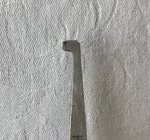I am having trouble with my recess tool-or more likely the tool is having trouble with me. As the tool engages and starts to form the recess it is effectively cutting on three “edges”. In addition (see photo) it increases in width slightly as the recess deepens. So in many cases it “digs in”. What am I doing wrong?! I did think about moving the tool “in and out” a bit to enlarge the recess and only cut with two “edges”.
Should I sharpen this with a diamond home just on the top face or the bevels on my low-speed wet grinder?

Should I sharpen this with a diamond home just on the top face or the bevels on my low-speed wet grinder?


